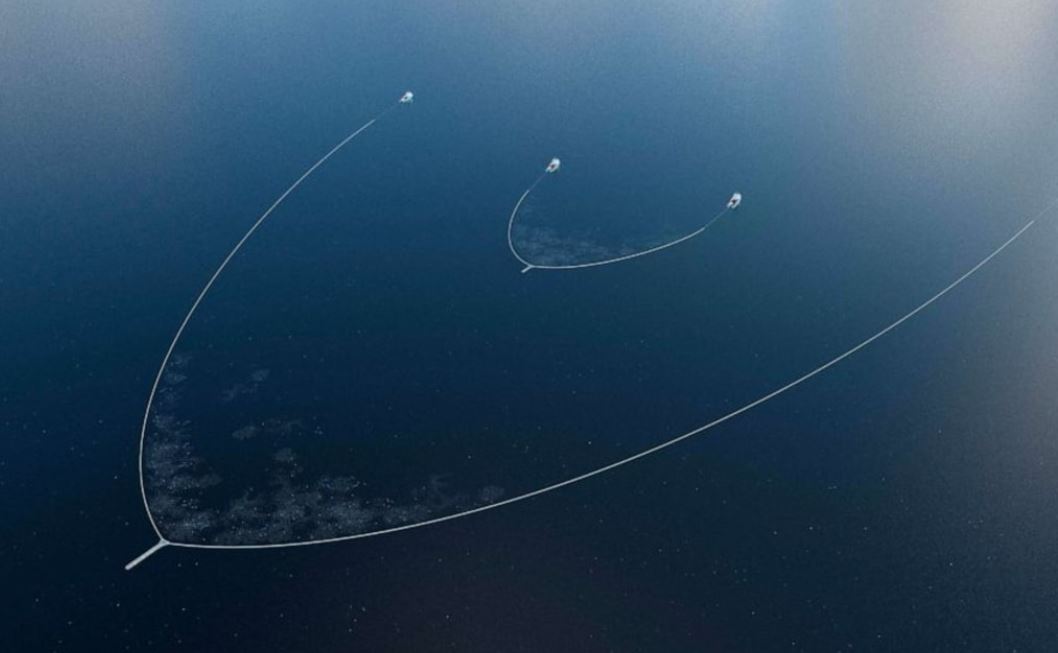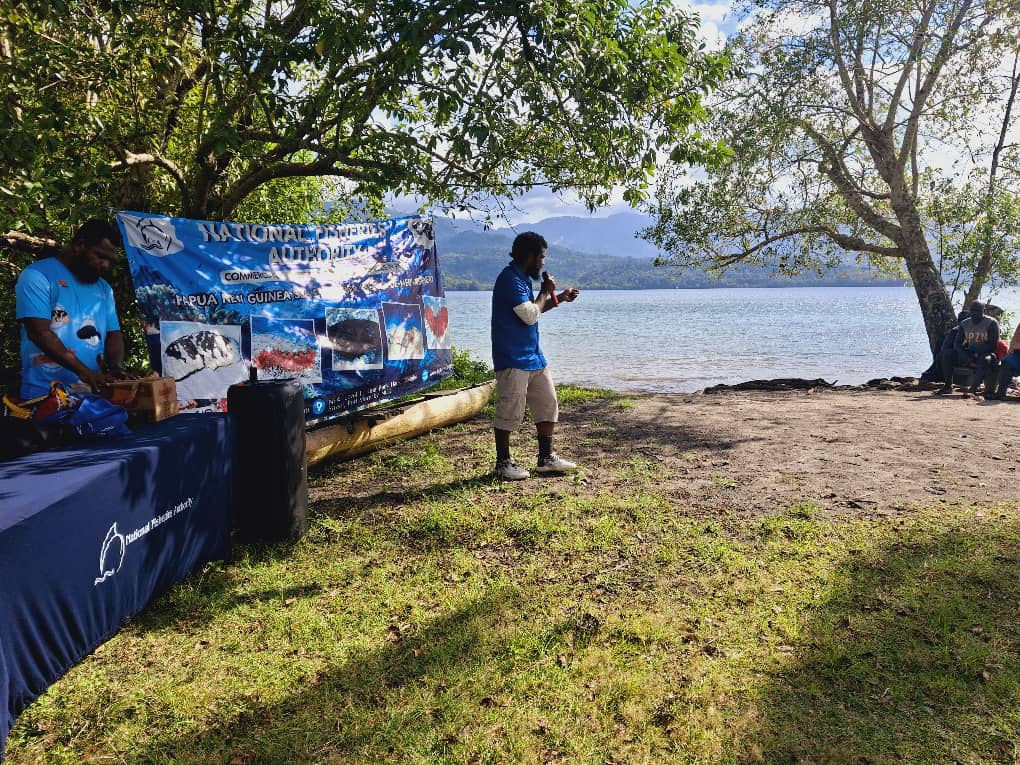 The Ocean Cleanup's "System 03" will be nearly three times as long as the previous system, enabling much more trash pickup. Photo: The Ocean Cleanup[/caption]
The nonprofit has a two-pronged approach of removing "legacy plastics" and debris before the UV rays break the material down into microplastics, which are nearly impossible to collect. One of the most remarkable items they have pulled is a Vietnam War-era canteen. Other common materials are rigid plastics that float into the ocean and fishing nets, Tobin said.
The system involves two vessels that have a device that skims the water to collect all of the debris.
The environmental group is also working to clear the rivers that feed into the oceans of trash as well to ensure they are able to clean as much as possible.
"Our goal is to kind of put ourselves out of business," Tobin said. "We don't want to be doing this forever and ever."
By the end of the month, The Ocean Cleanup will launch System 03, a larger version of its current system of floating barriers. Its predecessor, System 02, which was utilized in the most recent mission, is about 875 yards long. The new replacement measures at about 2,400 yards long, which will lead to much bigger and more successful catches, Tobin said.
System 03 is capable of clearing the size of a football field every five seconds, about twice the speed of the current system, Tobin said.
The nonprofit has also been using artificial intelligence computational modeling to locate where the most plastic is in the ocean -- a method they named "plastic hotspot modeling."
"It's sad that there's so much out there, but we're very happy that we now have developed a system that is tackling this more and more effectively," Tobin said.
During the week-long journey from the Great Pacific Garbage Patch back to port, the trash gets sorted on the ship, and the nonprofit recycles as much material as possible.
The nonprofit then works with partners worldwide to ensure that the products made with the recycled plastic are not ones that will end up back in oceans or rivers, Tobin said, adding that one of those partnerships is with a Korean car manufacturer that uses the plastics in the construction of electric vehicles.
"We just want to make sure it doesn't end up back where we found it," Tobin said.
Source: rnz.com
The Ocean Cleanup's "System 03" will be nearly three times as long as the previous system, enabling much more trash pickup. Photo: The Ocean Cleanup[/caption]
The nonprofit has a two-pronged approach of removing "legacy plastics" and debris before the UV rays break the material down into microplastics, which are nearly impossible to collect. One of the most remarkable items they have pulled is a Vietnam War-era canteen. Other common materials are rigid plastics that float into the ocean and fishing nets, Tobin said.
The system involves two vessels that have a device that skims the water to collect all of the debris.
The environmental group is also working to clear the rivers that feed into the oceans of trash as well to ensure they are able to clean as much as possible.
"Our goal is to kind of put ourselves out of business," Tobin said. "We don't want to be doing this forever and ever."
By the end of the month, The Ocean Cleanup will launch System 03, a larger version of its current system of floating barriers. Its predecessor, System 02, which was utilized in the most recent mission, is about 875 yards long. The new replacement measures at about 2,400 yards long, which will lead to much bigger and more successful catches, Tobin said.
System 03 is capable of clearing the size of a football field every five seconds, about twice the speed of the current system, Tobin said.
The nonprofit has also been using artificial intelligence computational modeling to locate where the most plastic is in the ocean -- a method they named "plastic hotspot modeling."
"It's sad that there's so much out there, but we're very happy that we now have developed a system that is tackling this more and more effectively," Tobin said.
During the week-long journey from the Great Pacific Garbage Patch back to port, the trash gets sorted on the ship, and the nonprofit recycles as much material as possible.
The nonprofit then works with partners worldwide to ensure that the products made with the recycled plastic are not ones that will end up back in oceans or rivers, Tobin said, adding that one of those partnerships is with a Korean car manufacturer that uses the plastics in the construction of electric vehicles.
"We just want to make sure it doesn't end up back where we found it," Tobin said.
Source: rnz.com NEWS
OCEAN CLEANUP GROUP REMOVES TONS OF RUBBISH
![]() By Kerebi DAVID |
August 18, 2023
By Kerebi DAVID |
August 18, 2023

 The Ocean Cleanup's "System 03" will be nearly three times as long as the previous system, enabling much more trash pickup. Photo: The Ocean Cleanup[/caption]
The nonprofit has a two-pronged approach of removing "legacy plastics" and debris before the UV rays break the material down into microplastics, which are nearly impossible to collect. One of the most remarkable items they have pulled is a Vietnam War-era canteen. Other common materials are rigid plastics that float into the ocean and fishing nets, Tobin said.
The system involves two vessels that have a device that skims the water to collect all of the debris.
The environmental group is also working to clear the rivers that feed into the oceans of trash as well to ensure they are able to clean as much as possible.
"Our goal is to kind of put ourselves out of business," Tobin said. "We don't want to be doing this forever and ever."
By the end of the month, The Ocean Cleanup will launch System 03, a larger version of its current system of floating barriers. Its predecessor, System 02, which was utilized in the most recent mission, is about 875 yards long. The new replacement measures at about 2,400 yards long, which will lead to much bigger and more successful catches, Tobin said.
System 03 is capable of clearing the size of a football field every five seconds, about twice the speed of the current system, Tobin said.
The nonprofit has also been using artificial intelligence computational modeling to locate where the most plastic is in the ocean -- a method they named "plastic hotspot modeling."
"It's sad that there's so much out there, but we're very happy that we now have developed a system that is tackling this more and more effectively," Tobin said.
During the week-long journey from the Great Pacific Garbage Patch back to port, the trash gets sorted on the ship, and the nonprofit recycles as much material as possible.
The nonprofit then works with partners worldwide to ensure that the products made with the recycled plastic are not ones that will end up back in oceans or rivers, Tobin said, adding that one of those partnerships is with a Korean car manufacturer that uses the plastics in the construction of electric vehicles.
"We just want to make sure it doesn't end up back where we found it," Tobin said.
Source: rnz.com
The Ocean Cleanup's "System 03" will be nearly three times as long as the previous system, enabling much more trash pickup. Photo: The Ocean Cleanup[/caption]
The nonprofit has a two-pronged approach of removing "legacy plastics" and debris before the UV rays break the material down into microplastics, which are nearly impossible to collect. One of the most remarkable items they have pulled is a Vietnam War-era canteen. Other common materials are rigid plastics that float into the ocean and fishing nets, Tobin said.
The system involves two vessels that have a device that skims the water to collect all of the debris.
The environmental group is also working to clear the rivers that feed into the oceans of trash as well to ensure they are able to clean as much as possible.
"Our goal is to kind of put ourselves out of business," Tobin said. "We don't want to be doing this forever and ever."
By the end of the month, The Ocean Cleanup will launch System 03, a larger version of its current system of floating barriers. Its predecessor, System 02, which was utilized in the most recent mission, is about 875 yards long. The new replacement measures at about 2,400 yards long, which will lead to much bigger and more successful catches, Tobin said.
System 03 is capable of clearing the size of a football field every five seconds, about twice the speed of the current system, Tobin said.
The nonprofit has also been using artificial intelligence computational modeling to locate where the most plastic is in the ocean -- a method they named "plastic hotspot modeling."
"It's sad that there's so much out there, but we're very happy that we now have developed a system that is tackling this more and more effectively," Tobin said.
During the week-long journey from the Great Pacific Garbage Patch back to port, the trash gets sorted on the ship, and the nonprofit recycles as much material as possible.
The nonprofit then works with partners worldwide to ensure that the products made with the recycled plastic are not ones that will end up back in oceans or rivers, Tobin said, adding that one of those partnerships is with a Korean car manufacturer that uses the plastics in the construction of electric vehicles.
"We just want to make sure it doesn't end up back where we found it," Tobin said.
Source: rnz.com Related News
LATEST NEWS






